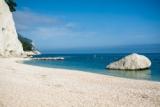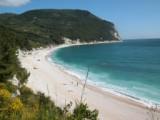
Fabriano
Piazza del Comune, 4-0732 709 480
http://www.fabrianoturismo.it/
info@fabrianoturismo.it
The first core of the town of Fabriano is located on the current site in 411 citizen, as a result of the barbarian invasions, there was the abandonment of the previous settlements, which the Iron Age to the Romans saw the two centers to develop Attidium and Tuficum Horse of the Umbria and Marche.
The population of Tuficum, founded also other neighboring settlements such Albacina, Moscano, Castelletta current surroundings of the City.
In 571 the town became part of the Duchy of Spoleto, but with the arrival of the Lombards before Charlemagne and then by 773 rose numerous feudal castles and Benedictine monasteries economically and spiritually important in a period of great struggles and insecurities.
The Fabriano today is the result of these periods early medieval, feudal castles in which two places on the banks of the river, at the time called Castellano, joined in a single center so that in the thirteenth century. already boasts the title of Sovereign Municipality.
The whole structure that is gradually developing in the next century includes the wall which joins the two centers founders, the Palazzo del Podesta, neighborhoods still exist which S.Venanzio, St. John and St. Blaise, also the Piazza high-born as the administrative area, and Piazza low they develop businesses.
Fabriano important city of “guilds of Arts” first of all that the Blacksmiths with 38 fabbrerie, a vocation that the city still celebrates its Palio city of St. John. More important are the wool, tanning, paper that will become important in its economy over the centuries, nationally and internationally.
But there was a dark and civil forfeiture when the family of Chiavalli came to power and speculate ‘on the people using citizens and its economy, limited freedom and rights by placing strict rules for corporate orders, a period that ended in so rough with the expulsion and murder of the Lords and the settlement of the Sforza, but also Francis established a policy that resulted in a continuation of economic decline Fabriano, so that its citizens and the entire civil community vowed to Church .
In later centuries the various struggles, famine, earthquakes and the resulting economic and social crisis tested the center that this decline also lost political autonomy and only towards the end of 1700 the paper industry had a new development thanks to Miliani family.
Many were the shifts and changes of political government until the unification of Italy, the State of the Church to the Kingdom of Italy, the Government of Naples to the Austrians, Fabriano emerges as a courageous and hardworking city that never gave up even when he spared historical fortunes were not favorable.
The center offers visitors different itineraries on foot, facilitated by the many signs present, whose starting points are the various car parks and arrival points which are to facilitate the use of the visitor. Going towards the center you can easily get to the Town Square at the end of the course the city where it opens our eyes with a medieval fountain Sturinalto (1285), symbol of the city, commissioned to Jacopo Grondolo that was inspired by the model JOHN PISAN and His fountain of Perugia a few years earlier, a typical gothic building with an octagonal base with three vertical tanks of which the last of Bronze. Around this square are many examples of civil architecture symbolism of citizens powers that have ruled over the centuries between them in an ancient rivalry between ecclesiastical powers, stately and then municipal, first of all, behind the fountain the majestic Palazzo del Podesta (1255) a late-Gothic building so little decorated with white stone bridge structure when once flowed beneath the ancient waterway citizen, under the same arch features decorations in fresco of the XIII-XIV century. archittettura impressive that under the period of the papacy became the Apostolic Palace.
On the right of the square we find the LOGGIATO of S.FRANCESCO half of ‘400 designed to connect the imposing church of the same name went then destroyed with the Town Hall. As every local architecture is then modified and expanded in the various historical periods. By Pope Nicholas V, when he moved his court in the city to escape the plague. The monumental PALACE OF COMMON 1350 is then reconstructed in 1690 and was the former home of the Family Chiavelli. Inside, we find in the courtyard of the ancient Roman artifacts and previous insediamenti.A close the square is the Episcopalian Building and its civic tower ancient residence of priors before and after the Bishops, the tower was rebuilt following the collapse in mid-1500 .
Passing under the arch of the Palazzo del Podesta we can see in the street adjoining the entrance, with the Gothic portal in stone, oratory OF CHARITY, inside fresco decorations in the Urbino painter Filippo Bellini. The structure and was reopened to the public in 1997 after they moved the municipal library materials that were kept inside.
Going up the hill that is to the left of the Palazzo del Podesta you get to the Cathedral Square, named in 1728 and named the Church of S.Venanzio dated XIV – XVII century. A structure semore late Gothic was enlarged by architect Muzio Oddi of Urbino between 1607 and 1617, the same period are the valuable stucco decorations by Francesco Selva. The previous period are the fourteenth-century Gothic polygonal apse, the cloister and the Chapel of San Lorenzo painted by Nuzi in 1360 ca. as well as other dynamic decorations in fresco of “Fabriano school” dating back to the fourteenth and fifteenth century ..
A separate discussion deserve the current exhibition curated by critic V. Sgarbi that in addition to its headquarters within the CIVIC PICTURE GALLERY “Bruno Majolati” entitled “From Giotto to Dear” also contains a path that extends to other sites within the historic center and in which the critic holds a path that includes pictorial art and decorative fresco, art wooden expanding the boundaries of the exhibition a licensing path of Churches, where as in the Cathedral you can contemplate all year works and decorations, splendid example of what numerous studies is defined SCHOOL FABRIANO a gothic style that incorporates the features and characteristics of the school of Giotto. The Art Gallery is located opposite the Cathedral, former Hospital of St. Mary of Jesus was built in 1456 by St. James of the Marches in its passage evangelizer in Fabriano, this keeps the original facade with a large porch at 5 arches, a munumentale late Gothic complex that was born to bring together all the structures osoedaliere towns.
The exhibition currently open has been extended until January, following several appearances and received acclaim nationally and internationally for the first time it brings the luceun distinctive dell ‘Arte Marche until today undervalued.
All the religious architecture is considered part of this artistic dialogue, the Church of St. Dominic Gothic building in 1365 ca. Where we find the coat of arms of the Family Chiavelli and here the work of decorator Allegretto Nuzi. In the Convent of St. Dominic find an important decoration in the Chapter House of Antonio da Fabriano, 1460, always inside the convent the MUSEUM OF PAPER, a very important historical path of the production processes from the Middle Ages and its historical evolution.
The exhibition also includes the Church of St. Mary of the Good Jesus originally built as a hospital town.
In the Church of St. Augustine factory late thirteenth century are preserved two extraordinary Gothic chapels frescoed by the Master of St. Emiliano, the Giotto school and an equally important wooden sculpture oratory painted by Lorenzo Salimbeni from San Severino.
Another fourteenth-century wooden sculpture depicting St. Nicholas of Bari can be found in the Collegiate of St. Nicholas Benedictine foundation, a complex that is situated near Piazza Garibaldi and made the Master of the Magi of Fabriano ..
In the same square we can admire the Portico of Vasari, so titled after its sale to the same in 1400; such was the importance of the arts congregations towns as this porch dating back to 1200 was part of the economic complex of the city as this was the market square, a fresco decoration of the school the Allegretto.
It is impossible to summarize all the architectural manifestations of the city, both civil and ecclesiastical, the beautiful scenery and natutalistiche, curiosities offering, traditions, folklore of this very important joint Marche, you can only strongly recommend a visit and every porch or portal of the church in any way, or gash it will open a unique show, a throwback to the Middle Ages, in a walk in the old town to discover.






 The finds along the slopes of Conero suggest that the territory of Sirolo was already inhabited in prehistoric times, and specifically in the neolithic age (about a hundred thousand years ago). Turning to the IV-III century BC, we find that the Greeks had already begun to build the support points along the coast. The civilization that gave however, to the territory of historical and cultural imprint SIROLO very special, was the Piceno, which are preserved innumerevolil and living testimonies. Sirolo, he is known as a land of heroic warriors, through the centuries, has been known for its power, its strength, thanks to its massive towers, its walls, its impregnable position that allowed him to withstand the attacks of assailants, they were Greeks, Saracens, the Barbarians or the powerful Malatesta Lord of Rimini (1416).
The finds along the slopes of Conero suggest that the territory of Sirolo was already inhabited in prehistoric times, and specifically in the neolithic age (about a hundred thousand years ago). Turning to the IV-III century BC, we find that the Greeks had already begun to build the support points along the coast. The civilization that gave however, to the territory of historical and cultural imprint SIROLO very special, was the Piceno, which are preserved innumerevolil and living testimonies. Sirolo, he is known as a land of heroic warriors, through the centuries, has been known for its power, its strength, thanks to its massive towers, its walls, its impregnable position that allowed him to withstand the attacks of assailants, they were Greeks, Saracens, the Barbarians or the powerful Malatesta Lord of Rimini (1416). Passing a huge leap, to times closer to us, namely the third and fourth centuries BC, we find that the Greeks had already begun to build the support points along the coast. They were attracted not only by the beauty of women, aromatic taste wine, abundant fruit (strawberry, cherry, almond, walnuts), the game (deer, wild boar) and by the spring waters that flowed abundant. The civilization that gave, however, to the territory of historical and cultural imprint Sirolo very special, was the Piceno, which are preserved countless lives and testimonies.
Passing a huge leap, to times closer to us, namely the third and fourth centuries BC, we find that the Greeks had already begun to build the support points along the coast. They were attracted not only by the beauty of women, aromatic taste wine, abundant fruit (strawberry, cherry, almond, walnuts), the game (deer, wild boar) and by the spring waters that flowed abundant. The civilization that gave, however, to the territory of historical and cultural imprint Sirolo very special, was the Piceno, which are preserved countless lives and testimonies. Sirolo, he is known as a land of heroic warriors, through the centuries, has been known for its power, its strength, thanks to its massive towers, its walls, its impregnable position that allowed him to withstand the attacks of assailants, they were Greeks, Saracens, or Barbarians and even to the powerful
Sirolo, he is known as a land of heroic warriors, through the centuries, has been known for its power, its strength, thanks to its massive towers, its walls, its impregnable position that allowed him to withstand the attacks of assailants, they were Greeks, Saracens, or Barbarians and even to the powerful